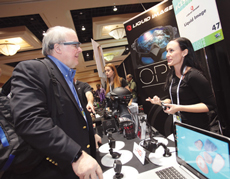
If last month’s International CES show had a strong message for providers, it was this: Being connected to the Internet is about to take on a whole new meaning.
From monitoring physical plant changes to improving security to upgrading resident care, Internet-linked tech devices are poised to bring dramatic changes to the sector.
In all, there will be about 50 billion Internet-connected devices in the marketplace by 2050, according to some analysts. Should that happen, virtually every aspect of senior living stands to be directly or indirectly affected by a new wave of Web-linked products and services.
“Internet connectivity is already starting to transform things in pretty significant ways,” said Scott McGregor, president and chief executive of Broadcom, an Irvine, CA-based company that makes the semiconductors that will likely help power this shift.
“There is going to be an absolute explosion of new devices,” he predicted.
So it’s not much of a surprise that the Internet received strong attention at CES (formerly the Consumer Electronics Show) in Las Vegas.
As in previous years, new laptops and smartphones were conspicuous. But much of the buzz was directed at special exhibits for smart home and wearable computers, especially those that provide Internet-connected fitness and health information.
With sensors becoming smaller and cheaper, manufacturers are showing that almost any object can be tied to the Internet. That includes watches, durable medical equipment and even building thermostats.
“The smart home is going to be built brick by brick until 10 years from now,”said Kelly Davis-Felner, a representative of the Wi-Fi Alliance. “We’re going to be looking back and saying, ‘Wow, I can’t believe there used to be a time when everything wasn’t connected.’”
By extension, this will also happen to long-term care and other senior living settings, she added.
From the February 01, 2014 Issue of McKnight's Long-Term Care News




